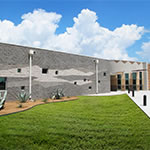McAllen, Texas, is almost Mexico. It occupies approximately 40 square miles of the southernmost tip of the state and sits on the Rio Grande River, directly across from the Mexican city Reynosa. Long an architectural leader in this diverse community, ERO Architects has become known for its expertise in educational design by connecting culture, learning, and sustainability. The firm leads the region in creating LEED-certified facilities, and its principals, Eli Ochoa and Manuel Hinojosa, pride themselves on their respect for the rich history of the community they serve.
“It is important that the students stay connected to the history of the community, and we think that understanding a bit of the past creates a positive learning environment,” says Ochoa, a native of the Rio Grande Valley and a former school board trustee.
ERO often uses repurposed materials from the community in the construction of new facilities, which not only saves clients money, but also incorporates historical elements into the school’s design. Ochoa says he believes that clean, healthy, and more efficient environments are better vehicles for quality education.

The lecture halls of University Center are equipped with remote cameras for online attendees.
SEVERE EXPOSURES
The state-of-the-art University Center at Texas State Technical College in Harlingen was the first building south of San Antonio to receive LEED Gold certification. In addition to being built on a previously developed site, the educational facility takes advantage of natural light and features a sophisticated air quality system. The college also won a grant to install a solar panel array on the building’s roof. “One of the things that’s hard to do in the Valley is to try to design in more of a passive way because you have so many severe exposures,” Hinojosa says. “You’ll find very few buildings that have a combination of active and passive solar elements, but this building does.” ™籶
The building supports both on-site and online learning, so lecture halls are set up so students can comfortably see, hear, and learn from any seat, while remote cameras pan to each speaker to capture student participation in real time. True to ERO’s philosophy of “respecting the land, people, and history,” an exterior wall features a weave pattern inspired by Coahuiltecans, a group of American Indian tribes that inhabited the region prior to the 1800s. ERO also repurposed lumber from old Army Air Corps barracks to create the beams that run across the interior ceilings and the focal wall.

The lobby features a distinct wall of worn wood that comes from an old Army Air Corps barracks.
Nearby, the Donna Independent School District’s 3-D Academy is currently the only LEED-certified public school in the Rio Grande Valley. Geared toward young adults, the school’s three ‘D’s stand for “dedication,” “desire,” and “determination,” and the institution provides a second chance for academic success. Students can earn college credits while completing their high school education through a dual-enrollment program.
To achieve a healthful and low-impact environment, low-VOC paints, adhesives, and sealants were selected to reduce indoor air contaminants, and 75 percent of construction waste was diverted from landfills. Thanks to green design decisions made regarding indoor climate control and water consumption, the school district has experienced a 12 percent savings in energy costs and a 30 percent savings in utility costs.
“Everything was working together—from the grounds to the building, inside and outside,” Hinojosa says. Design elements complement the history and climate of the area. Materials create a more natural, rather than modular, look to the exterior, and indigenous plants beautify the grounds without requiring irrigation. Communal spaces, where students and teachers can engage outside of the classroom, flow from the inside to the outside and provide protection from the sun while helping conserve energy.

The exterior of the 3-D Academy features indigenous plants and designs that reference the culture and history of South Texas.
IN THE RING
Although the architects have succeeded in paying homage to the history of South Texas, they also are looking toward the future with a commitment to designing for needs of the 21st century. “With all the technology and competition out there, the student today requires a different environment in order to learn,” Hinojosa says. To understand the needs of today’s educators, ERO’s principals are putting themselves in students’ shoes. “We’re starting all over again in how we approach the space that we work in,” he says. Hinojosa and Ochoa are also in the process of gutting the ERO office to create open spaces featuring cutting-edge technologies and functional furniture, effectively giving up their offices to be “in the ring” with their employees, hoping to better facilitate communication and collaboration.
Currently, the architects are proposing to use DIRTT walls—digital, glass panels that allow daylight to enter through the entire office—as well as modular carpet tiles, water-based paints and stains, and sustainable construction materials. By experiencing new products and design innovations themselves, ERO hopes to make more informed decisions for clients in their immediate community and beyond.

